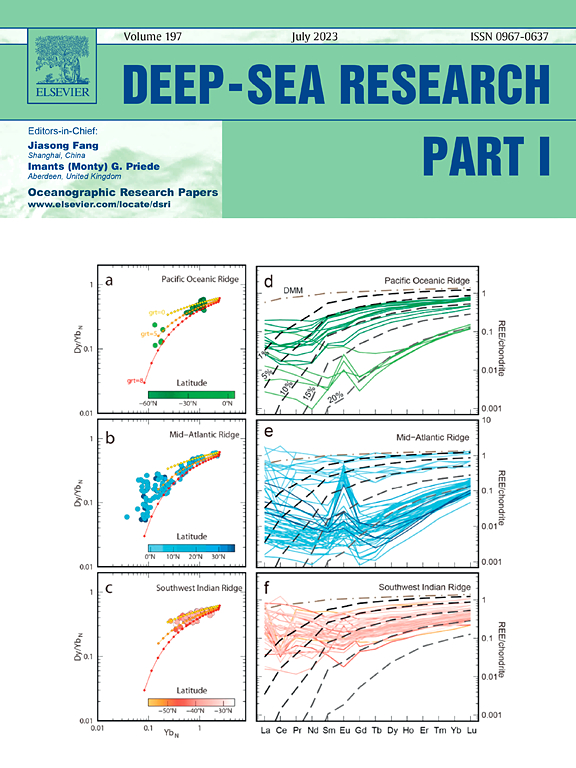- 充值
- 帮助

The journal is concerned with fundamental oceanography of the deep sea in the broadest sense. This includes, ocean physics including circulation, waves, turbulence, thermodynamics, optics, acoustics, mixing, or other process studies, atmosphere ocean coupling, primary production, organic carbon fluxes, chemistry, palaeoceanography, geophysics, sedimentology, all aspects of biology from microbes to marine mammals, physiology, ecology, biogeography, evolution, behaviour and anthropological impacts. Instruments and Methods papers can describe novel hardware, vehicles, research vessels, instrumentation, sensors (physical, chemical or biological), survey methods, analysis and calibration methods as well as software and novel data-analysis techniques but with the caveat of evidence of successful use in oceanography. We do not accept applied science/technology papers on deep-sea mining, drilling, bio-prospecting or management of fish stocks in which the aim is not oceanographic research. In biological papers, we welcome descriptions of new species but these should be in the context of advancing knowledge of ecology, evolution and biogeography in the deep sea; purely taxonomic papers should be submitted to a specialist journal. Deep-Sea Research Part I: Oceanographic Research Papers, considers four types of paper: Research Papers: These should report results of original scientific research, including theoretical work of evident oceanographic applicability. To encourage full reporting of complex studies there is no formal length limit on research papers but editors and reviewers will discourage excessive verbosity and repetition. Instruments and Methods: These should report novel solutions of instrumental or methodological problems with evidence of successful use. There is no length limit. Short Communication: These can be reports of novel research or instruments and methods and should not contain more than 4,000 words and no more than 3 figures and 1 table. Reviews: The journal welcomes suggestions for reviews synthesising knowledge of any aspect of the deep sea. These reviews should be approximately 12,000 words in length and suggestions should be discussed with the Editors-in-Chief. Special Collections of papers: Proposals for special topic issues should be directed to our sister journal: Deep-Sea Research Part II: Topical Studies in Oceanography. However, this journal can publish collections of up to 5 papers that address a special topic that are insufficient to fill a whole journal volume. Proposals for special collections should be discussed with an Editor-in-Chief. The proponent of a special collection may be appointed as a Special Section Guest Editor. Papers can be submitted in any order and at any time and will be handled in the normal way by the guest editor or established editors. Each paper will be published on-line as soon as it is accepted. When the final paper in the collection is accepted then the entire collection will be assigned to a volume and authors may suggest a cover image. Papers in a collection should be numbered consecutively with a short main title and more extensive subtitle. E.g. Ocean carbon fluxes 1: xxxxxxx, Ocean fluxes 2: yyyyyyyyyy. Each paper in the collection should be a self-standing and can be a Research Paper, Instruments and methods paper, Short Communication or Review. Guest editors may add an editorial introducing the section. For all papers, supplemental matter, such as extensive data tables or graphs and multimedia content, may be published as electronic appendices. Deposition of data, gene sequences and type specimens: This journal encourages sharing of data (see section on research data below) and recommends that data be placed in appropriate repositories or included in the supplemental matter submitted with the paper. New gene sequences should be deposited in the DDBJ/EMBL/GenBank database. Type specimens should be deposited in the appropriate national or international public museum or collection. Accession numbers of gene sequences and type specimens must be included in the final version of the manuscript and cannot be added at the proof stage.
- 主办单位: PERGAMON-ELSEVIER SCIENCE LTD
- 出版周期: 月刊
- 别名: 深海研究I
- 国际标准连续出版物号: ISSN 0967-0637
- 创刊时间: 1953年
- 曾用名: Deep-sea research. Part A, Oceanographic research papers
-
vol.131 (2018)
vol.131 (2018)
Jan. -
vol.115 (2016)
vol.115 (2016)
-
vol.107 (2016)
vol.107 (2016)
-
vol.95 (2015)
vol.95 (2015)
-
vol.90 (2014)
vol.90 (2014)
-
vol.88 (2014)
vol.88 (2014)
-
vol.83 (2014)
vol.83 (2014)
-
vol.71 (2013)
vol.71 (2013)
-
vol.59 (2011)
vol.59 (2011)
-
vol.58 (2011)
vol.58 (2011)
-
vol.58 (2010)
vol.58 (2010)
-
vol.57 (2010)
vol.57 (2010)
-
vol.57 (2009)
vol.57 (2009)
-
vol.56 (2009)
vol.56 (2009)
-
vol.56 (2008)
vol.56 (2008)
-
vol.55 (2008)
vol.55 (2008)
-
vol.55 (2007)
vol.55 (2007)
-
vol.54 (2007)
vol.54 (2007)
-
vol.54 (2006)
vol.54 (2006)
-
vol.53 (2006)
vol.53 (2006)
-
vol.53 (2005)
vol.53 (2005)
-
vol.52 (2005)
vol.52 (2005)
-
vol.52 (2004)
vol.52 (2004)
-
vol.51 (2004)
vol.51 (2004)
-
vol.51 (2003)
vol.51 (2003)
-
vol.50 (2003)
vol.50 (2003)
-
vol.49 (2002)
vol.49 (2002)
-
vol.48 (2001)
vol.48 (2001)
-
vol.47 (2000)
vol.47 (2000)
-
vol.46 (1999)
vol.46 (1999)
-
vol.45 (1998)
vol.45 (1998)
-
vol.44 (1997)
vol.44 (1997)
-
vol.43 (1996)
vol.43 (1996)
-
vol.42 (1995)
vol.42 (1995)
-
vol.41 (1994)
vol.41 (1994)
-
vol.40 (1993)
vol.40 (1993)
-
vol.58 (1989)
vol.58 (1989)
- 1
- 2
- 3
- 4

 分析评价
分析评价
